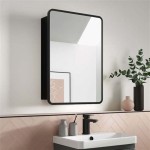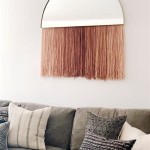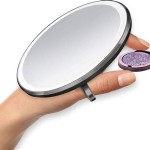Decorating Wooden Mirror Frames: A Comprehensive Guide
Wooden mirror frames offer a versatile canvas for creative expression. Their natural texture and inherent warmth provide an ideal foundation for a myriad of decorative techniques. The ability to customize a wooden mirror frame allows for seamless integration into existing décor, whether it be rustic, contemporary, or eclectic. This article explores various methods for decorating wooden mirror frames, providing detailed instructions and insights into the materials and techniques involved.
Before commencing any decorative project, proper preparation of the wooden frame is crucial. This typically involves cleaning the frame to remove any dust, dirt, or existing finishes. A mild soap and water solution, followed by thorough drying, is generally sufficient. For frames with existing paint or varnish, sanding may be necessary to create a smooth, receptive surface for subsequent coatings. The grade of sandpaper used will depend on the condition of the existing finish; coarser grits are suitable for removing thick layers, while finer grits are ideal for smoothing imperfections.
After cleaning and sanding, priming the wooden frame is highly recommended. Primer serves several key functions. It seals the wood, preventing uneven absorption of paint or other finishes. It provides a consistent surface for the topcoat, ensuring uniform color and adhesion. It can also block stains from bleeding through, especially if the frame is made from a wood with high tannin content, such as oak or redwood. A quality wood primer, applied in thin, even coats, will significantly enhance the final result. Allow the primer to dry completely according to the manufacturer’s instructions before proceeding with the decorative application.
The choice of decorative technique depends largely on the desired aesthetic and the skill level of the decorator. Simple painting, using acrylic or latex paints, is a common and accessible option. More advanced techniques, such as distressing, decoupage, or applying decorative moldings, require greater skill and specialized materials. The following sections will delve into specific approaches to decorating wooden mirror frames.
Painting Techniques for Wooden Mirror Frames
Painting is the most straightforward and widely used method for decorating wooden mirror frames. The possibilities are virtually limitless, encompassing a wide range of colors, finishes, and patterns. Acrylic paints, known for their durability and quick drying time, are a popular choice. Latex paints are also suitable, offering good coverage and ease of cleanup. Oil-based paints, while offering a richer color and harder finish, require more effort to apply and clean and are less environmentally friendly.
When painting, it is essential to apply thin, even coats. Multiple thin coats are preferable to a single thick coat, as they minimize the risk of drips and runs and ensure proper adhesion. Use a high-quality brush or foam roller to achieve a smooth, professional finish. For intricate details or hard-to-reach areas, a smaller brush may be necessary. Allow each coat to dry completely before applying the next. Light sanding between coats can help to smooth any imperfections and improve adhesion.
Specific painting techniques can create different effects. For example, dry brushing involves applying a small amount of paint to a brush and then wiping off most of the paint before applying it to the frame. This technique creates a textured, weathered look. Sponging involves using a sea sponge or synthetic sponge to apply paint to the frame, creating a mottled or stippled effect. Stenciling allows for the application of intricate patterns or designs using stencils and paint.
Consider the existing décor of the room when choosing a paint color. A neutral color, such as white, gray, or beige, can complement a wide range of styles. A bold or vibrant color can add a pop of interest to a more neutral space. Metallic paints, such as gold, silver, or copper, can add a touch of glamour and sophistication. Experiment with different color combinations and finishes to achieve the desired effect.
Distressing and Antiquing Wooden Mirror Frames
Distressing and antiquing techniques are used to create a worn, aged look on wooden mirror frames. These techniques are particularly well-suited for rustic, farmhouse, or vintage-inspired décor. Distressing involves physically removing some of the paint or finish to reveal the underlying wood, while antiquing involves applying glazes or stains to create a patina of age.
Several methods can be used to distress a wooden mirror frame. Sanding is a common technique, using sandpaper to rub away the paint or finish in areas that would naturally wear over time, such as edges, corners, and raised details. A heat gun can also be used to soften the paint, making it easier to scrape or peel away. Chipping involves using a chisel or other sharp tool to create small chips or cracks in the paint.
Antiquing glazes are typically applied after the paint has dried. These glazes are designed to settle into crevices and texture, highlighting details and creating a sense of depth. Apply the glaze liberally and then wipe away the excess with a clean cloth. The amount of glaze left behind will determine the intensity of the antiqued effect. Practice on a scrap piece of wood before applying the glaze to the mirror frame.
Another antiquing technique involves using a dry brush to apply a dark stain or glaze to the edges and corners of the frame. This technique creates a subtle shading effect that adds dimension and age. Experiment with different colors and techniques to achieve the desired level of distress and antiquing.
When distressing or antiquing a wooden mirror frame, it is important to consider the overall style of the room. A heavily distressed frame may not be appropriate for a modern or minimalist space. Choose techniques and finishes that complement the existing décor and enhance the overall aesthetic.
Adding Decorative Elements to Wooden Mirror Frames
Beyond painting and distressing, various decorative elements can be added to wooden mirror frames to enhance their visual appeal. These elements can include moldings, appliques, beads, shells, and other embellishments. The addition of decorative elements can personalize the frame and create a unique, eye-catching piece.
Moldings are a popular choice for adding architectural detail to wooden mirror frames. These moldings can be made of wood, resin, or plaster and come in a wide variety of styles and sizes. They can be attached to the frame using wood glue or nails. Consider the style of the room when choosing moldings. Simple, clean-lined moldings are suitable for modern spaces, while more ornate moldings are appropriate for traditional or Victorian-inspired rooms.
Appliques are decorative ornaments that can be glued or nailed to the frame. These appliques can be made of wood, resin, metal, or other materials. They come in a wide range of shapes and sizes, from simple floral designs to intricate scrollwork. Arrange the appliques in a pleasing pattern and secure them firmly to the frame.
Beads, shells, and other small embellishments can be used to add texture and visual interest to the frame. These embellishments can be glued to the frame using a strong adhesive. Consider the color and texture of the beads or shells when choosing them. Metallic beads can add a touch of glamour, while natural shells can create a coastal or beachy vibe.
Decoupage is a technique that involves gluing paper cutouts to the frame. Any type of paper can be used, from wallpaper scraps to magazine clippings to decorative napkins. Apply a thin layer of decoupage glue (such as Mod Podge) to the back of the paper cutout and then carefully position it on the frame. Smooth out any wrinkles or air bubbles with a soft cloth. Once the glue has dried, apply several coats of decoupage sealant to protect the paper and create a smooth, even surface.
Ultimately, the possibilities for decorating wooden mirror frames are limited only by imagination. By experimenting with different techniques and materials, a personalized and unique frame can be created that complements the home's décor and reflects individual style.

15 Creative Diy Mirror Frame Ideas Projects Home Decor Mirrors

Bold Solid Wood Mirror Frame For Room Decorations Bedroom Home

Easy Driftwood Mirror The Wood Grain Cottage
Explore The Unique Wood Frame Mirror Collections Accent
:max_bytes(150000):strip_icc()/alahome1-a879d69e31be4a9a9ae522028c12926d.jpg?strip=all)
20 Diy Mirror Frame Ideas To Inspire Your Next Project

Diy Wood Frame Mirror Makeover With Hooks Funky Junk Interiors

Wooden Mirror Frame Home Decor Housewarming Gift Bathroom

Wooden Frame Mirror Decorative Picture Decor Designs

Explore The Unique Wood Frame Mirror Collections Accent

Scrap Wooden Mirror Frame Decor Ideas For Your Home 2024








